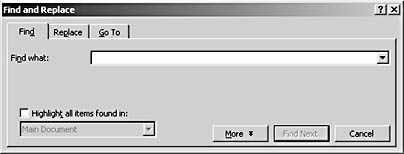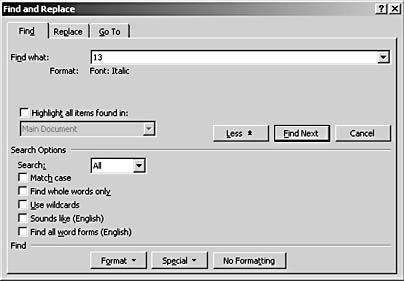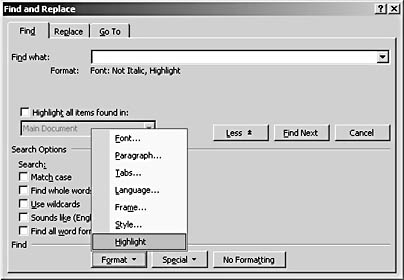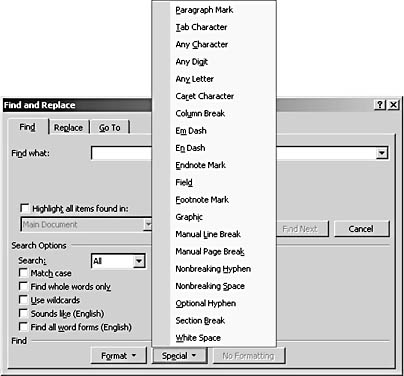Finding Text and Elements Within the Current Document
3 4
In addition to searching for documents and navigating through documents using the Document Map, you can search for text, graphics, and other document elements within the current document by using the Find, Replace, and Go To features. Find, Replace, and Go To are extremely popular tools among seasoned Word users because they are quick, accurate, and easy to use. And as an added bonus, Word 2002 tosses in a couple new twists to these tried-and-true favorites without eliminating any existing functionality. In this section, we'll take a closer look at the Find feature; we'll look at Replace and Go To in the two sections that follow.
To access the Find tab in the Find And Replace dialog box, shown in Figure 12-11, choose Edit, Find, or press Ctrl+F. Alternatively, you can click the Find button on the Select Browse Object menu. (To display the Select Browse Object menu, click the Select Browse Object button located near the bottom of the vertical scroll bar, or press Ctrl+Alt+Home.)

Figure 12-11. You can use the Find tab to locate instances of words, phrases, special characters, styles, and more.
In this section, you'll learn how to use the Find tab's various options; many of these options also appear on the Replace tab.
Tip - Add the Find Button to the Standard Toolbar
To add the Find button to the Standard toolbar, click the down arrow on the right end of the Standard toolbar, choose Add Or Remove Buttons, point to Standard, and then click the Find option.
Finding and Selecting Items
As an experienced Word user, you know that you can find characters, words, phrases, and text elements by typing a search string in the Find dialog box and then clicking Find Next to move from one instance of the search string to the next. In addition to the standard instance-by-instance Find capabilities, this version of Word lets you select every instance of a character, word, phrase, or text element at one time with a single click. To select every instance of a search text string, follow these basic steps:
- On the Find tab in the Find And Replace dialog box, type your search text in the Find What box.
- Select the Highlight All Items Found In check box, ensure that Main Document is selected in the drop-down list, and then click Find All. (The Find Next button changes to the Find All button after you select the Highlight All Items Found In check box.)
- Click Close to close the dialog box.
When all instances of a search string are selected, you can globally format the selected text by clicking toolbar buttons or applying Format menu options. You can also delete all the selected text by pressing Delete or Backspace. To deselect the selected text, simply click an unhighlighted area within your document.
Configuring Options on the Find Tab
In many cases, conducting a simple text search using the Find tab adequately serves your needs. But you'll also encounter situations when you want to further refine your search parameters. To define more specific searches or to search for document elements, you'll need to use the Find And Replace dialog box's additional options. To view the additional options on the Find tab, click the More button. The fully expanded Find tab is shown in Figure 12-12.
The Find options in Word 2002 are fundamentally the same as the Find options in Word 2000, so taking advantage of the advanced Find capabilities in this version of Word will be very familiar to Word 2000 users. But let's take a moment to review the expanded Find tab's options. (Keep in mind that most of these options are also available on the Replace tab.)

Figure 12-12. The expanded version of the Find dialog box provides access to search options as well as the Format, Special, and No Formatting buttons. Notice that the More button has changed to a Less button; you can click the Less button to shrink the dialog box to its original view.
The following Search options are available on the expanded Find tab:
- The Search box enables you to specify whether to search Down, Up, or All. When you choose All, Word searches the entire document by starting at the insertion point, searching to the end of the document, moving to the beginning of the document, and then searching until reaching the insertion point again. When you choose Down or Up, Word starts from the insertion point and searches only in the specified direction; with the Up and Down options, Word does not search headers, footers, footnotes, or comments.
- Match Case specifies a search that distinguishes between uppercase and lowercase letters based on the text entered in the Find What box.
- Find Whole Words Only searches only for whole words, not parts of longer words. For example, if you type the in the Find What text box and select Find Whole Word Only, Word will ignore words that contain the, such as them, there, other, and so forth.
- Use Wildcards enables you to use wildcard characters in place of text to expand and refine your searches. If you enter wildcard characters in the Find What box without selecting the Use Wildcards option, Word will treat the wildcards as plain text. Table 12-1 lists the wildcards you can use in the Find And Replace dialog box. When the Use Wildcard check box is selected and you want to search for a character that is also a wildcard, precede the character with a backslash (\). For example, to search for an asterisk, you must enter \*.
- Sounds Like searches for terms that sound like the word or words entered in the Find What box. For example, if you enter eight in the Find What box and then select the Sounds Like check box, Word will find all instances of eight as well as ate. This feature works only with legitimate words—entering the number 8 and selecting the Sounds Like check box won't return eight, ate, or 8, and entering u r won't return you are.
- Find All Word Forms searches for all forms of the word entered in the Find What box. For example, if you enter speak in the Find What box, Word will find speak, speaking, spoke, spoken, speaks, and so forth. This option is unavailable when you select the Use Wildcards or Sounds Like check box.
Table 12-1. Using Wildcards in the Find And Replace Dialog Box
| Wildcard | Specifies | Example |
|---|---|---|
? | Any single character | p?t finds pet, pat, pit, and so forth. |
* | Any string of characters | p*t finds pest, parrot, pit, and so forth. |
< | Finds the text at the beginning of a word | <(mark) finds market but not demark. |
> | Finds the text at the end of a word | (ter)> finds winter but not terrain. |
[ ] | Finds one of the enclosed characters | t[oa]n finds ton and tan. |
[-] | Finds any character within the specified range | [r-t]ight finds right, sight, and tight. |
[!x-z] | Finds any single character except characters in the range inside the brackets | cl[!a-m]ck finds clock and cluck but not clack or click. |
{n} | Finds exactly n occurrences of the preceding character or expression | ble{2}d finds bleed but not bled. |
{n,} | Finds at least n occurrences of the preceding character or expression | fe{1,}d finds fed and feed. |
{n,m} | Finds from n to m occurrences | 10{1,3} finds 10, 100, and 1000.of the preceding character or expression |
@ | Finds one or more occurrences of the preceding character or expression | mo@d finds mod and mood. |
Finding Instances of Formatting
In addition to finding text strings, you can find (and replace) various formatting settings. To view the available formatting parameters on the expanded Find tab, click the Format button, as shown in Figure 12-13.

Figure 12-13. You can find instances of formatting by choosing options available on the Format drop-down menu.
Choosing Font, Paragraph, Tabs, Language, Frame, or Style on the Format drop-down menu opens the corresponding formatting dialog box. For example, choosing Font opens a dialog box named Find Font, which looks very similar to the Font dialog box. Choosing the Highlight option lets you specify highlighted or unhighlighted text in the Find What box. For example, choose Highlight once to find highlighted text, choose Highlight again to indicate that you want to find text that is not highlighted, and choose Highlight a third time to find all instances of the search text regardless of highlighting. When formatting is applied to text in the Find What box, the formatting information appears below the Find What box, as you can see in Figure 12-13.
Tip - Control Formatting Using Keyboard Shortcuts
You can control basic character formatting by using keyboard shortcuts. To do so, click in the Find What box and press keyboard shortcuts such as Ctrl+B (bold), Ctrl+I (italic), and Ctrl+U (underline) to toggle among applied, not applied, and neither (which equates to no formatting) settings.
You can find instances of formatting without entering text in the Find What box. For example, the configuration shown in Figure 12-13 will find only instances of highlighted text that isn't italic in the current document. You can, of course, specify text in combination with formatting settings if that's what you need to find.
To clear all formatting commands in the Find What box, click the No Formatting button. You'll want to clear formatting when you complete one Find operation and are ready to conduct another.
Finding Special Characters Using Codes
Word further expands your search capabilities by providing special codes you can use to find document elements, such as paragraph marks, tab characters, endnote marks, and so forth. To view the available special characters, click the Special button in the Find And Replace dialog box, as shown in Figure 12-14.

Figure 12-14. You can search for special character and document elements by choosing options on the Special drop-down menu or by inserting character codes directly in the Find What box (or the Replace With box on the Replace tab).
When you choose an option on the Special drop-down menu, a code is inserted in the Find What box. If you'd prefer, you can enter a code directly in the Find What box. Table 12-2 lists some commonly used special character codes. (Notice that some codes can be used only in the Find What or in the Replace With box, and that the Use Wildcards option must be turned on or off in certain instances.)
Table 12-2. Using Special Character Codes in the Find And Replace Dialog Box
| Special character | Code | Find And Replace box |
|---|---|---|
ANSI or ASCII characters | ^0nnn (where nnn is the character code) | Find What; Replace With |
Any character | ^? | Find What (with the Use Wildcards check box cleared) |
Any digit | ^# | Find What (with the Use Wildcards check box cleared) |
Any letter | ^$ | Find What (with the Use Wildcards check box cleared) |
Caret | ^^ | Find What; Replace With |
Column break | ^n | Find What; Replace With |
Contents of the Find What box | ^& | Replace With |
Em dash | ^+ | Find What; Replace With |
En dash | ^= | Find What; Replace With |
Endnote | ^e | Find What (with the Use Wildcards check box cleared) |
Field | ^d | Find What (with the Use Wildcards check box cleared) |
Footnote | ^f | Find What (with the Use Wildcards check box cleared) |
Graphic | ^g | Find What (with the Use Wildcards check box selected) |
Manual line break | ^| | Find What; Replace With |
Nonbreaking hyphen | ^~ | Find What; Replace With |
Nonbreaking space | ^s | Find What; Replace With |
Optional hyphen | ^- | Find What; Replace With |
Paragraph mark | ^p | Find What (with the Use Wildcards check box cleared); Replace With |
Section break | ^b | Find What (with the Use Wildcards check box cleared) |
Tab | ^t | Find What; Replace With |
White space | ^w | Find What (with the Use Wildcards check box cleared) |
Windows Clipboard contents | ^c | Replace With |
EAN: 2147483647
Pages: 337